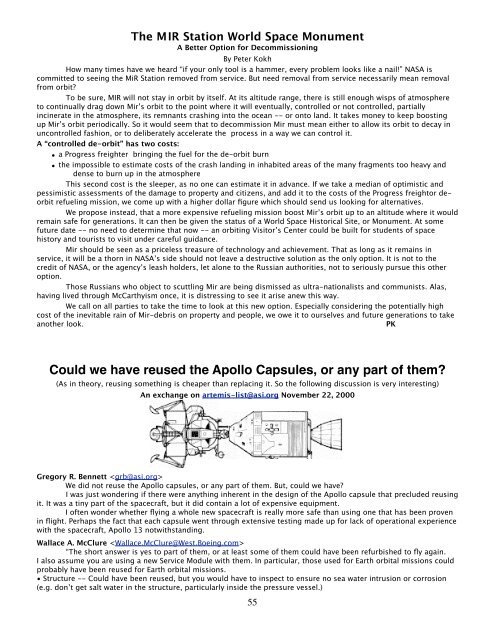Space Transportation - mmmt_transportation.pdf - Moon Society
Space Transportation - mmmt_transportation.pdf - Moon Society
Space Transportation - mmmt_transportation.pdf - Moon Society
Create successful ePaper yourself
Turn your PDF publications into a flip-book with our unique Google optimized e-Paper software.
The M IR Station World <strong>Space</strong> Monument<br />
A Better Option for Decommissioning<br />
By Peter Kokh<br />
How many times have we heard “if your only tool is a hammer, every problem looks like a nail!” NASA is<br />
committed to seeing the MiR Station removed from service. But need removal from service necessarily mean removal<br />
from orbit?<br />
To be sure, MIR will not stay in orbit by itself. At its altitude range, there is still enough wisps of atmosphere<br />
to continually drag down Mir’s orbit to the point where it will eventually, controlled or not controlled, partially<br />
incinerate in the atmosphere, its remnants crashing into the ocean -- or onto land. It takes money to keep boosting<br />
up Mir’s orbit periodically. So it would seem that to decommission Mir must mean either to allow its orbit to decay in<br />
uncontrolled fashion, or to deliberately accelerate the process in a way we can control it.<br />
A “controlled de-orbit” has two costs:<br />
• a Progress freighter bringing the fuel for the de-orbit burn<br />
• the impossible to estimate costs of the crash landing in inhabited areas of the many fragments too heavy and<br />
dense to burn up in the atmosphere<br />
This second cost is the sleeper, as no one can estimate it in advance. If we take a median of optimistic and<br />
pessimistic assessments of the damage to property and citizens, and add it to the costs of the Progress freightor deorbit<br />
refueling mission, we come up with a higher dollar figure which should send us looking for alternatives.<br />
We propose instead, that a more expensive refueling mission boost Mir’s orbit up to an altitude where it would<br />
remain safe for generations. It can then be given the status of a World <strong>Space</strong> Historical Site, or Monument. At some<br />
future date -- no need to determine that now -- an orbiting Visitor’s Center could be built for students of space<br />
history and tourists to visit under careful guidance.<br />
Mir should be seen as a priceless treasure of technology and achievement. That as long as it remains in<br />
service, it will be a thorn in NASA’s side should not leave a destructive solution as the only option. It is not to the<br />
credit of NASA, or the agency’s leash holders, let alone to the Russian authorities, not to seriously pursue this other<br />
option.<br />
Those Russians who object to scuttling Mir are being dismissed as ultra-nationalists and communists. Alas,<br />
having lived through McCarthyism once, it is distressing to see it arise anew this way.<br />
We call on all parties to take the time to look at this new option. Especially considering the potentially high<br />
cost of the inevitable rain of Mir-debris on property and people, we owe it to ourselves and future generations to take<br />
another look. PK<br />
Could we have reused the Apollo Capsules, or any part of them?<br />
(As in theory, reusing something is cheaper than replacing it. So the following discussion is very interesting)<br />
An exchange on artemis-list@asi.org November 22, 2000<br />
Gregory R. Bennett <br />
We did not reuse the Apollo capsules, or any part of them. But, could we have?<br />
I was just wondering if there were anything inherent in the design of the Apollo capsule that precluded reusing<br />
it. It was a tiny part of the spacecraft, but it did contain a lot of expensive equipment.<br />
I often wonder whether flying a whole new spacecraft is really more safe than using one that has been proven<br />
in flight. Perhaps the fact that each capsule went through extensive testing made up for lack of operational experience<br />
with the spacecraft, Apollo 13 notwithstanding.<br />
Wallace A. McClure <br />
“The short answer is yes to part of them, or at least some of them could have been refurbished to fly again.<br />
I also assume you are using a new Service Module with them. In particular, those used for Earth orbital missions could<br />
probably have been reused for Earth orbital missions.<br />
• Structure -- Could have been reused, but you would have to inspect to ensure no sea water intrusion or corrosion<br />
(e.g. don’t get salt water in the structure, particularly inside the pressure vessel.)<br />
55















